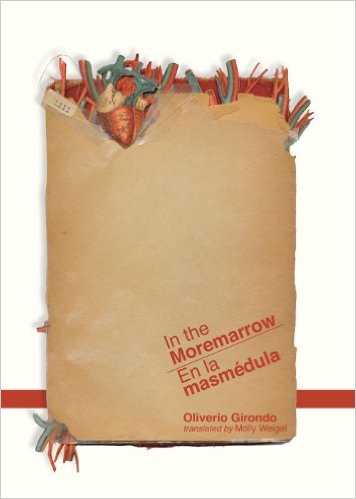
In the Moremarrow / En la masmedula
by Oliverio Girondo
Translated by Molly Weigel.
Poetry. Latino/Latina Studies. Bilingual Edition.
ISBN: 9780983148074
15 April 2013
$16
The final volume by the vanguard poet of 20th century Argentinian literature.
“In the fabled history of experimental South American literature, Girondo’s En la masmédula stands alongside Trilce as a marker of the fruitful extremes to which that modernism — anywhere & everywhere can take us.”
— Jerome Rothenberg
“A milestone for the history of poetry in Spanish. […] I celebrate the publication of this book.”
— Cecilia Vicuña
ABOUT THE AUTHOR
Born in Buenos Aires, Argentina, on August 17, 1891, Oliverio Girondo studied and traveled widely in Europe as a young man, serving as a European correspondent for Argentine literary magazines including Plus ultra and Caras y caretas and establishing close friendships with writers and artists who introduced him to surrealism and other vanguard movements. Among Girondo’s circle of friends and influences throughout his life were Blaise Cendrars, Salvador Dalí, Macedonio Fernandez, and Frederico Garcia Lorca, as well as Rafael Alberti and Pablo Neruda, both of whom dedicated poems to him.
His first book, Veinte poemas para ser leidos en un tranvia, was published by a small French press in 1922, and Calcomanias was published in Span in 1925. He belonged to Argentine ultraist vanguard, which also included Jorge Luis Borges, and returned to Argentina in 1924 to cofound the ultraist magazine Martín Fierro, for which he wrote the manifesto. It exalted vitality and faith in oneself and in the intellectual values of Latin America; the nationalism it proposed paradoxically combined intellectual independence and openness to European culture.
Espantapajaros (1932), Interlunio (1937), and Persuasion de los días (1942) were all published in Buenos Aires. Ultraism started to dissolve in 1927; Espantapajaros begins with a questioning of the referential function of language and a declaration of nihilism, elements that would continue in his work and culminate in En la masmédula.
In 1943, Girondo married fellow writer Norah Lange, and during the mid-1940s their house in Buenos Aires served as a meeting place for the younger literary generation, including Francisco Madariaga, Enrique Molina, Olga Orozco, and Aldo Pellegrini. Girondo and Lange were so close that Moline coined the term “Noroliverio” to refer to the couple. In 1946 Girondo published Campo nuestro, a single long poem. The first poems that would constitute En la masmédula were published by Aldo Pellegrini in the magazine Letra y linea in 1953, and the definitive edition appeared in 1956. Widely considered his greatest work, En la masmédula closes the Latin American modernist tradition begun in the 1920s and simultaneously opens the door to more recent experimentalism. In 1961, Girondo was injured in a car accident which left him with diminished faculties. He died in Buenos Aires on January 24, 1967.
ABOUT THE TRANSLATOR
Molly Weigel is a poet, translator, and therapist living near the Delaware River in central New Jersey with her husband, son, and four cats. She has published poems in Verse Wisconsin and MiPoesias and has published two books of poetry translation with Action Books: The Shock of the Lenders, by Jorge Santiago Perednik, which appeared in 2012, and In the Moremarrow, by Oliverio Girondo, for which she received a 2008 NEA fellowship.